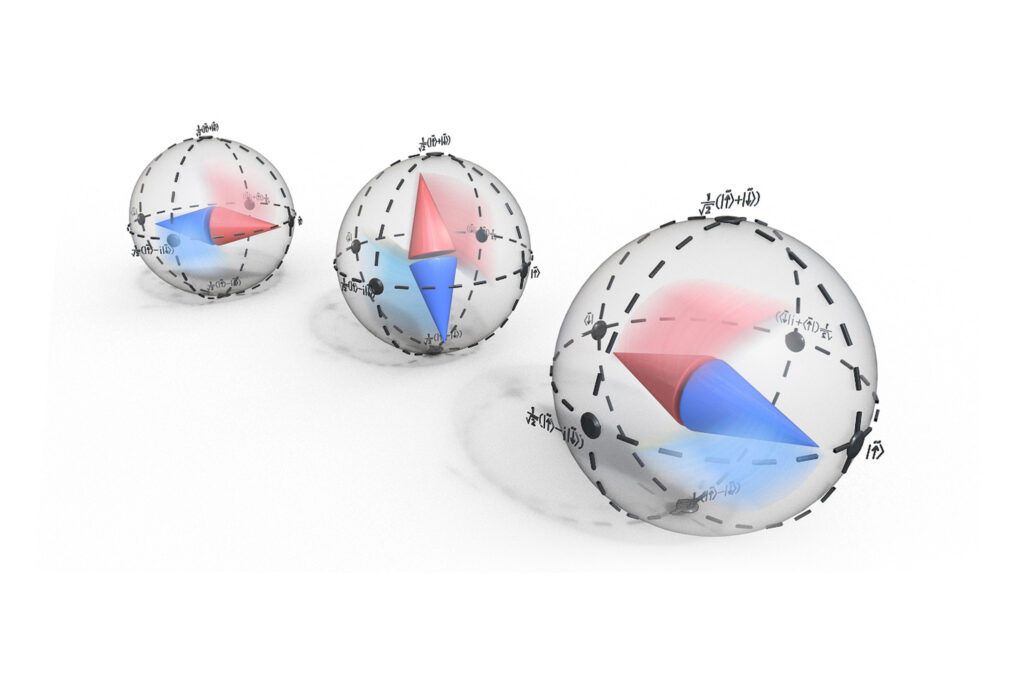New perspectives for information technologies
A team of researchers from the Technical University of Munich (TUM), the Bavarian Academy of Sciences and Humanities, and the Norwegian University of Science and Technology (NTNU) in Trondheim have discovered an exciting method for controlling spin carried by quantized spin wave excitations in antiferromagnetic insulators.

Elementary particles carry an intrinsic angular momentum known as their spin. For an electron, the spin can take only two particular values relative to a quantization axis, letting us denote them as spin-up and spin-down electrons. This intrinsic two-valuedness of the electron spin is at the core of many fascinating effects in physics.
In today’s information technology, the spin of an electron and the associated magnetic momentum are exploited in applications of information storage and readout of magnetic media, like hard disks and magnetic tapes.
Antiferromagnets: future stars in magnetic data storage?
Both, the storage media and the readout sensors utilize ferromagnetically ordered materials, where all magnetic moments align parallel. However, the moments may orient in a more complex way. In antiferromagnets, the “antagonist to a ferromagnet“, neighboring moments align in an anti-parallel fashion. While these systems look “non-magnetic” from outside, they have attracted broad attention as they promise robustness against external magnetic fields and faster control. Thus, they are considered as the new kids on the block for applications in magnetic storage and unconventional computing.
One important question in this context is, whether and how information can be transported and detected in antiferromagnets. Researchers at the Bavarian Academy of Sciences and Humanities, the Technical University of Munich (TUM) and the Norwegian University of Science and Technology (NTNU) in Trondheim studied the antiferromagnetic insulator hematite in this respect.
In this system, charge carriers are absent and therefore it is a particularly interesting testbed for the investigation of novel applications, where one aims at avoiding dissipation by a finite electrical resistance. The scientists discovered a new effect unique to the transport of antiferromagnetic excitations, which opens up new possibilities for information processing with antiferromagnets.
Unleashing the pseudospin in antiferromagnets
Dr Matthias Althammer, the lead researcher on the project describes the effect as follows: “In the antiferromagnetic phase, neighboring spins are aligned in an anti-parallel fashion. However, there are quantized excitations called magnons. Those carry information encoded in their spin and can propagate in the system. Due to the two antiparallel-coupled spin species in the antiferromagnet the excitation is of a complex nature, however, its properties can be cast in an effective spin, a pseudospin. We could experimentally demonstrate that we can manipulate this pseudospin, and its propagation with a magnetic field.”
Dr Akashdeep Kamra, the lead theoretician from NTNU in Trondheim adds that “this mapping of the excitations of an antiferromagnet onto a pseudospin enables an understanding and a powerful approach which has been the crucial foundation for treating transport phenomena in electronic systems. In our case, this enables us to describe the dynamics of the system in a much easier manner, but still maintain a full quantitative description of the system. Most importantly, the experiments provide a proof-of-concept for the pseudospin, a concept which is closely related to fundamental quantum mechanics.”
Unlocking the full potential of antiferromagnetic magnons
This first experimental demonstration of magnon pseudospin dynamics in an antiferromagnetic insulator not only confirms the theoretical conjectures on magnon transport in antiferromagnets, but also provides an experimental platform for expanding towards rich electronics inspired phenomena.
“We may be able to realize fascinating new stuff such as the magnon analogue of a topological insulator in antiferromagnetic materials” points out Rudolf Gross, director of the Walther-Meißner-Institute, Professor for Technical Physics (E23) at the Technical University of Munich and co-speaker for the MCQST. “Our work provides an exciting perspective for quantum applications based on magnons in antiferromagnets”
